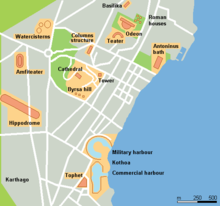Antoninus-Pius-Thermen
The Antoninus-Pius-Thermen ( French Thermes d'Antonin ) are a Roman bathing facility from the 2nd century in the ancient city of Carthage in Tunisia . With an extension of 200 meters, they were the largest thermal baths in the African provinces of Rome . The ruins can now be viewed in the Parc archéologique des Thermes d'Antonin and are part of the UNESCO World Heritage Site .
history
The baths were built between 146 and 162 AD based on the model of the Trajan baths in Rome, symmetrically around a 20 m × 50 m central room. They take their name from the Roman Emperor Antoninus Pius , an adopted son of Emperor Hadrian , who at least helped finance the construction. They are the first public baths to be built in the city of Carthage and were decorated with imported marble and mosaics. The thermal baths remained in operation until the Vandals invaded North Africa in the 5th century. As a result, a large part of the valuable building materials and the columns for the construction and decoration of other structures were removed.
architecture
Due to the location of the thermal baths directly by the sea, it was not possible, as is usual with comparable buildings, to set up the operating and staff rooms in a basement. They were therefore moved to the ground floor and the actual bathrooms on the first floor. These were divided into two symmetrical sections with caldaria , tepidaria and swimming pool, presumably separate for men and women. Centrally located were the frigidarium , whose dome was supported by eight gray granite columns with marble capitals, and a large cold water swimming pool ( natatio ) measuring 49 m × 6 m. The water was supplied with water from the Bordj-Djedid cisterns, which were fed with water from the Zaghouan Mountains via the Zaghouan aqueduct .
Todays situation
The ruins of the thermal baths can now be viewed as part of an archaeological park . Above all, the remains of the ground floor can be seen, which mainly consisted of staff and relaxation rooms. The heating and water pipes are also partly easy to see. Hardly anything has been preserved from the marble decorations and columns, as well as from the actual bathrooms, and the former flight of stairs to the sea was completely destroyed. In the middle of the thermal bath building, an approx. 20 meter high column was erected again on a concrete base. It shows the height of the frigidarium at this point. The remains of the semicircular latrines can be seen a little outside the actual thermal bath buildings. In the excavation area there are also a number of Punic graves, cisterns, the foundation walls of several houses (some with mosaic floors), the ruins of an early Christian basilica and the underground, so-called burial chapel of Asterius. The site of the archaeological park is directly adjacent to the site of the Palace of the Presidents of Tunisia.
literature
- Alexandre Lézine: Les thermes d'Antonin à Carthage. Société tunisienne de diffusion, Tunis 1969.
Web links
Individual evidence
- ^ Marietta Horster : Building inscriptions of Roman emperors . Franz Steiner Verlag, Stuttgart 2001, ISBN 3-515-07951-3 , pp. 416-417 .
- ↑ Titus Aurelius Fulvus Boionus Arrius Antoninus (Pius). imperiumromanum.com, accessed January 11, 2015 .
- ^ Antoninus-Pius-Thermen. tunesieninformation.de, accessed on January 11, 2015 .
- ↑ Natasha Sheldon: The Antonine Baths, Carthage. Ancient History an Archeology, accessed January 11, 2015 .
- ↑ Alexandre Lézine, Noël Duval: La chapelle funéraire souterraine dite d'Astérius, à Carthage. In: Mélanges d'archéologie et d'histoire. 71, 1959, pp. 339-357 ( digitized version ).
Coordinates: 36 ° 51 ′ 15.6 ″ N , 10 ° 20 ′ 6.4 ″ E




